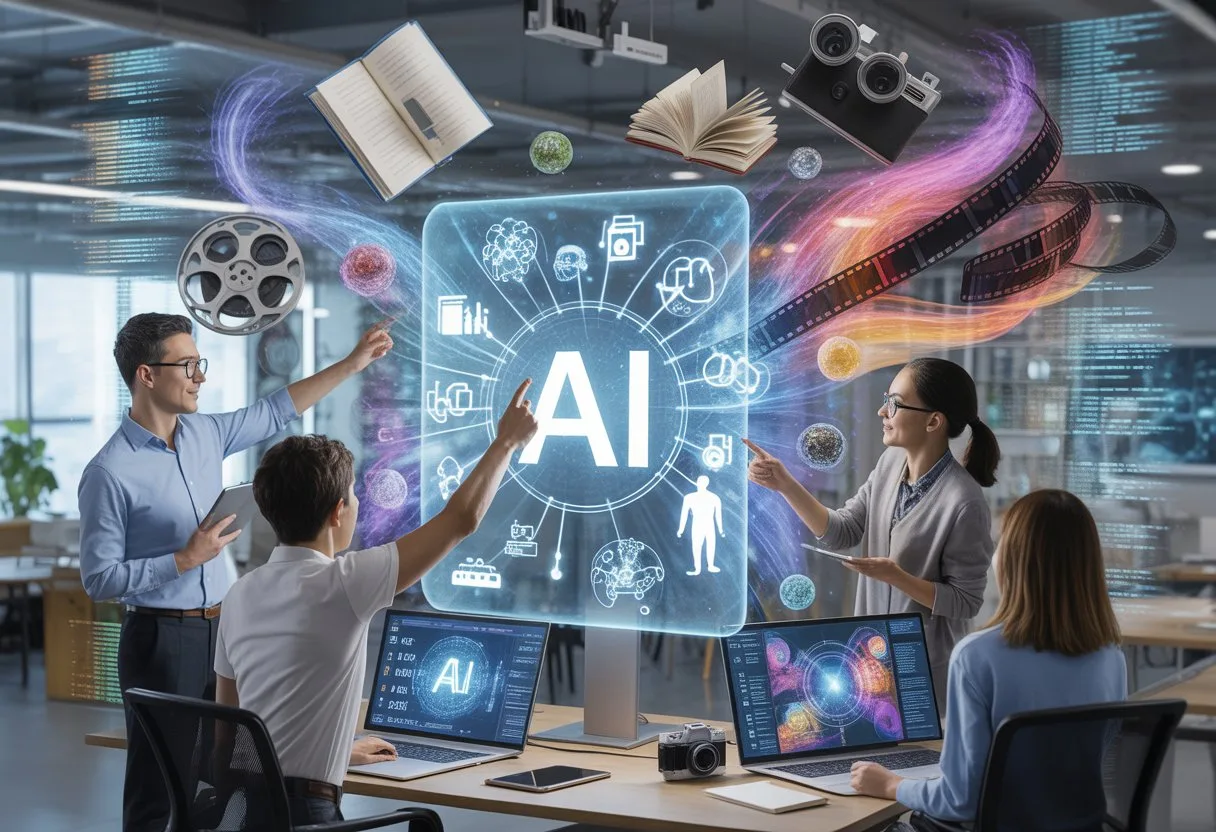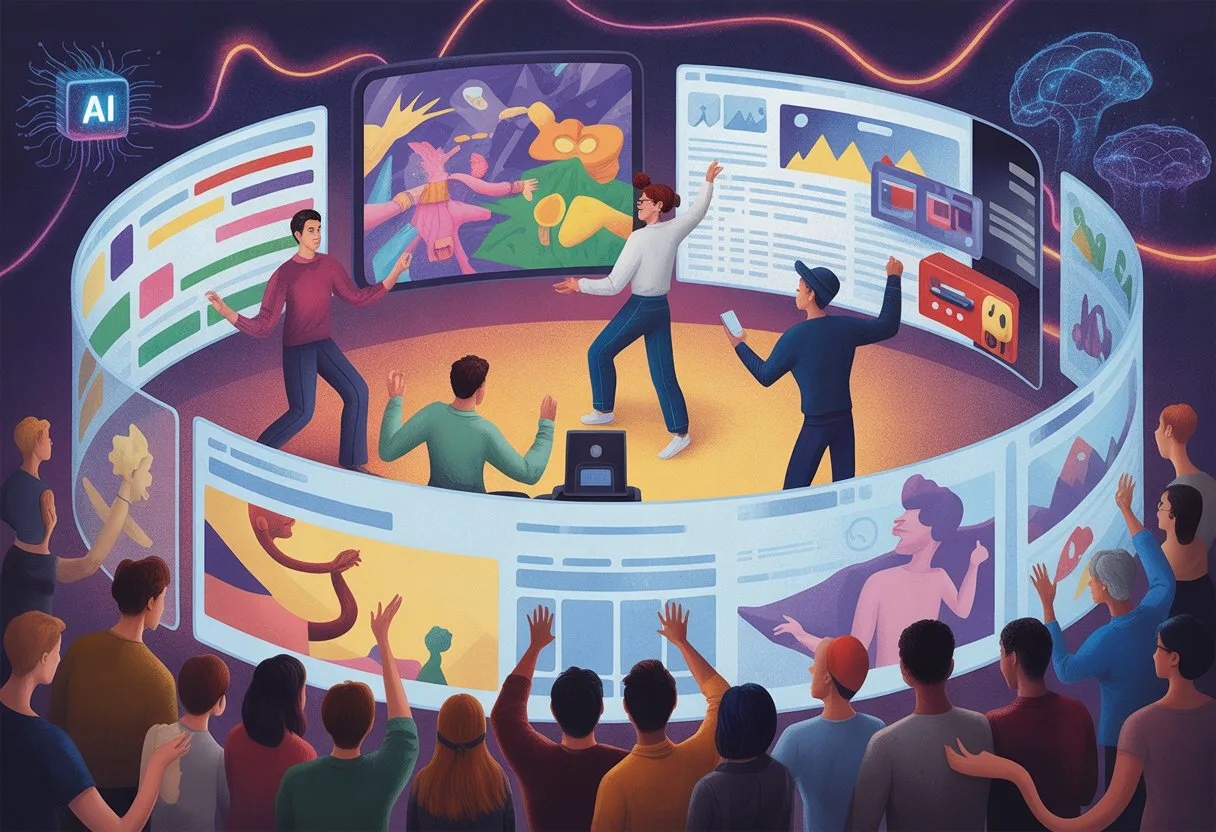Visual storytelling has changed forever with the rise of artificial intelligence. AI-powered visual storytelling uses machine learning to automatically create images, videos, and interactive media that bring stories to life without requiring advanced technical skills. What once took teams of designers and hours of work can now happen in seconds with the right AI tools.
We’re witnessing a shift where anyone can transform their ideas into compelling visual narratives. These AI systems learn from millions of examples to generate consistent characters, create storyboards, and produce professional-quality content. Tools like LTX model are enabling creators to focus on their stories while AI handles complex visual production.
The technology goes beyond simple image creation. Modern AI storytelling platforms can understand context, maintain visual consistency across scenes, and even respond to user interactions.
This opens up new possibilities for marketers, educators, filmmakers, and content creators who want to engage their audiences with rich visual experiences.
Core Concepts of AI-Powered Visual Storytelling
AI-powered visual storytelling combines artificial intelligence tools with traditional narrative techniques to create compelling visual content.
This approach maintains human creative control while using technology to enhance story development, visual creation, and audience engagement.
Defining AI-Powered Storytelling
AI-powered storytelling uses machine learning algorithms to help creators develop narratives and visual content. The technology transforms written ideas into visual formats through automated processes.
Deep learning systems form the backbone of these tools. Convolutional neural networks process visual data, while recurrent neural networks handle sequential elements of storytelling.
We see AI helping with three main areas:
- Script development – generating dialogue and plot suggestions
- Visual creation – producing artwork, animations, and video clips
- Character design – creating consistent character appearances and traits
The technology doesn’t replace human storytellers. Instead, it serves as a creative partner, accelerating production and opening new possibilities for visual expression.
Key Elements of Visual Storytelling
Visual storytelling uses images, videos, and graphics to convey narratives that connect emotionally with audiences. These elements work together to create lasting impressions.
Core visual components include:
- Character design and development
- Scene composition and backgrounds
- Color schemes and visual themes
- Movement and animation sequences
AI enhances each element by automating repetitive tasks and suggesting creative options. We can generate multiple visual variations quickly, test different artistic styles, and maintain consistency across long narratives.
Storyboarding becomes more efficient with AI assistance. The technology helps us plan visual sequences, suggest camera angles, and draft scenes before final production.
Modern AI tools can produce artwork in a variety of styles, from realistic images to cartoon animations. This flexibility lets us match visual elements to our story’s tone and target audience.
The Role of Human Creativity in AI-Driven Narratives
Human creativity remains central to AI-powered visual storytelling. We provide the vision, emotional depth, and cultural understanding that machines cannot replicate.
Our creative input shapes every aspect:
- Story themes and emotional messages
- Character personalities and motivations
- Cultural context and social awareness
- Artistic direction and style choices
AI works best when we give it clear instructions through prompt engineering. The quality of our prompts directly affects the creative output we receive from AI systems.
We maintain creative control by making final decisions about visual elements, narrative structure, and audience engagement strategies. AI suggests options, but we choose the ones that fit our vision.
Collaboration works both ways. AI can inspire us with unexpected visual combinations or plot suggestions we might not have considered. This partnership often leads to more innovative storytelling approaches than either humans or AI could achieve on their own.
Enhancing Audience Engagement and Empowering Creators
AI transforms how creators connect with their audiences through data insights and automated tools. These technologies help us understand viewer preferences while giving creators more time to focus on storytelling.
Strategies to Boost Audience Engagement
We can use AI to study how audiences behave and what content they prefer. This data helps us create stories that match what viewers want to see.
Personalized content works better than generic approaches. AI analyzes viewing habits to suggest which stories will appeal to specific groups. We can tailor our visual elements, pacing, and themes based on this information.
Interactive storytelling keeps audiences involved. AI-powered platforms let viewers make choices that change the story. This creates a personal connection between the audience and our content.
Real-time feedback helps us adjust quickly. AI tools track engagement metrics like watch time, clicks, and shares. We can see which parts of our stories work best and improve future content.
Smart recommendation systems boost discovery. When we use AI to suggest related content, audiences stay engaged with our work longer.
Tools and Platforms for Creators
Modern AI tools make visual storytelling easier and faster. LTX Video offers creators an all-in-one platform for transforming ideas into polished videos using AI-driven editing, voiceovers, and templates.
Canva Pro offers innovative design suggestions and automated layouts. We can create professional graphics without advanced design skills.
Lumen5 automatically turns written content into videos. The platform selects relevant images and creates smooth transitions. This saves hours of manual editing work.
Artbreeder helps generate unique visual elements. We can blend different art styles to create original characters and backgrounds for our stories.
Video editing platforms use AI to handle repetitive tasks. These tools can cut scenes, add music, and create effects automatically. We spend less time on technical work and more time on creative decisions.
Natural language processing tools help write better scripts. They suggest improvements to dialogue and story structure based on successful content patterns.
Best Practices for Integrating AI with Creative Work
We should use AI as a helper, not a replacement for creativity. The best results come when we combine human imagination with AI efficiency.
Start small with one or two AI tools. Learn how they work before adding more to our workflow. This prevents us from feeling overwhelmed by new technology.
Keep our creative voice when using AI suggestions. These tools provide options, but we decide what fits our story best. Our personal style should still show through the final work.
Test different approaches to see what works. AI provides data on audience reactions, so we can try new ideas and measure the results. This helps us improve over time.
Balance automation with a personal touch. Use AI for technical tasks like editing and formatting. Focus our human effort on storytelling, character development, and emotional connections.
Regular training on new AI features keeps our skills up to date. The technology changes quickly, so we need to stay up to date with the latest tools and methods.
FAQs
Many creators want to know about specific tools, costs, and limitations when starting with AI visual storytelling. These questions cover the most popular platforms, free options, and practical considerations for different skill levels.
What are the top-rated apps for AI-powered visual storytelling?
Midjourney leads the market for generating high-quality visuals from text prompts. It creates detailed images quickly and works well for brands competing in crowded digital spaces.
Reelmind.ai specializes in video creation with multi-scene generation and style adaptation features. The platform offers custom model training for more personalized results.
DeepSeek-V3 provides beginner-friendly tools for creating complete visual stories. Users can craft specific prompts to describe their desired scenes and messages.
Are there any free tools available for creating AI-driven visual narratives?
Several platforms offer free tiers for basic visual storytelling needs. These typically include limited generation credits or watermarked outputs.
Visual Storyteller provides free AI-generated visuals that transform text narratives into images. The tool works well for writers, educators, and marketers starting their visual storytelling journey.
Many premium platforms offer free trials that let users test features before committing to paid plans. These trials usually last 7-14 days with full access to core functions.
Which platforms offer the best features for generating AI-assisted video stories?
Video-focused platforms provide automated scene transitions and style consistency across multiple clips. These tools handle the technical aspects while users focus on storytelling.
Platforms with multi-scene capabilities allow creators to build complete narratives with connected visual elements. They maintain character consistency and visual flow throughout longer stories.
Real-time adaptation features enable dynamic content that responds to viewer preferences and engagement data. This creates more personalized storytelling experiences.
How does Mootion AI enhance the experience of digital storytelling?
We cannot provide specific details about Mootion AI’s features based on the information available to us. The platform’s capabilities and unique offerings require direct research from official sources.
Users interested in Mootion AI should check the platform’s official website for current features and pricing. This ensures access to the most accurate and up-to-date information.
What are the limitations of using AI in creating compelling visual stories?
AI tools require specific prompts to generate desired results. Vague or unclear descriptions often produce unsatisfactory visuals that need multiple attempts to refine.
Technical skills still matter for advanced customization and fine-tuning. While AI reduces barriers, creators benefit from understanding basic design principles and storytelling techniques.
Cost considerations affect regular usage of premium AI tools. High-quality generation often requires paid subscriptions that can add up for frequent creators.
AI-generated content may lack the nuanced creativity and emotional depth that human artists bring to visual storytelling. The technology works best when combined with human creative input.
Can Katalist help beginners effectively create stories, and how does it compare with other storytelling tools?
We cannot provide specific information about Katalist’s features or effectiveness based on the available search results. Direct platform research would be needed for accurate comparisons.
Beginners should evaluate any storytelling tool based on ease of use, available tutorials, and community support. These factors often matter more than advanced features when starting.
Platform comparisons should focus on specific needs, such as video vs. image creation, pricing models, and output quality. Testing multiple tools through free trials helps identify the best fit for individual projects.



